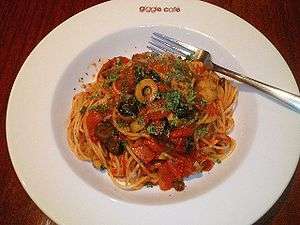Cookbook:Spaghetti alla Puttanesca
Cookbook | Ingredients | Recipes
| Cuisine of Italy | Pasta Recipes
| Spaghetti alla Puttanesca | |
|---|---|
 | |
| Category | Italian recipes |
| Time | 1 hour |
Spaghetti alla puttanesca (Italian: "whore's spaghetti") is a spicy, tangy and somewhat salty Italian pasta dish. Italians refer to the sauce as sugo alla puttanesca.
The earliest reference to spaghetti alla puttanesca in print, cited by the Grande dizionario della lingua italiana, occurred in Raffaele La Capria’s 1961 novel Ferito a morte. Also, Italy's Professional Association of Pasta Makers agrees the sauce became popular in the 1960s.[1]
Origin
According to Annarita Cuomo, writer for Il Golfo, a newspaper serving the Italian islands of Ischia and Procida, sugo alla puttanesca was invented in the 1950s by Sandro Petti, co-owner of Rancio Fellone, a famous Ischian restaurant and nightspot.[2]
The moment of inspiration came, writes Cuomo, when near closing one evening Petti found a group of hungry friends sitting at one of his tables. Petti was low on ingredients and told them he didn't have enough to make them a meal. They complained that it was late and they were hungry. "Facci una puttanata qualsiasi" (“make any kind of garbage”), they insisted. In this usage, puttanata is a noun meaning garbage or something worthless. It is also derived from the Italian word puttana, meaning whore.
Petti had nothing more than four tomatoes, two olives and some capers; the basic ingredients for the sugo. “So I used them to make the sauce for the spaghetti,” Petti told Cuomo.
Later, Petti included the dish on his menu as spaghetti alla puttanesca.
Cooking with chili peppers
This recipe calls for chili peppers. Choosing the right quantity and type of pepper depends on your personal taste and a bit of trial and error. For this dish, most chefs use peppers in the moderate range of the Scoville scale. Use one or one and a half small peppers the first time you make this recipe. Use one and a half or two small peppers if your first attempt at making sugo leaves you craving more pepper heat. Keep increasing the number of peppers until you get it right. Most chefs stop at three.
Recipes
Ingredients vary a bit among chefs and cooks according to individual tastes. However, the version from Lazio always includes anchovies while the Neapolitan version never does.[3][4]
An Italian-American version of this dish has emerged that omits butter and oregano but includes onions, anchovies and chili peppers.[5] Also, Americans tend to call the Italian-American version pasta puttanesca rather than spaghetti alla puttanesca.
Finally, both recipes below contain very little protein. However, shrimp and scallops sautéd in olive oil go beautifully with this dish. If you can't eat shellfish then add canned tuna or broiled salmon to the pasta before coating it with sugo.
Lazio recipe (serves six to eight)
Ingredients
- 600 grams (21 ounces) of spaghetti
- 50 grams (1.75 ounces) of butter
- 3 tablespoons of extra virgin olive oil
- 6 unsalted anchovy fillets, crushed into a paste (omit anchovies for Neapolitan version)
- 3 cloves of garlic, finely chopped
- 200 grams (7 ounces) of black olives, pitted and chopped
- 1 tablespoon of salted capers, washed well and coarsly chopped
- 1 to 3 small dried chili peppers, chopped (optional)
- 600 grams (21 ounces) plum tomatoes, peeled and puréed
- 1 tablespoon of chopped parsley
- salt to taste
Procedure
- Put the following in a skillet: butter, olive oil, garlic and anchovy paste.
- Before the garlic browns, add the olives, capers, tomato sauce and chili peppers.
- Add two to three pinches of salt, mixing at high heat.
- Meanwhile, cook the spaghetti in salt water (at least 4 quarts of water per pound of spaghetti being cooked). Strain it when it's al dente. Place it in a large serving bowl and coat it with sauce. Then sprinkle it with chopped parsley.
- Mix and serve hot.
Italian-American recipe (serves two)
Ingredients
- 3 tablespoons olive oil
- 6 ounces (170 grams) onions, finely chopped
- 2 cloves garlic, minced
- 4 anchovy fillets chopped or 2 teaspoons anchovy paste
- 2 teaspoons capers, thoroughly rinsed
- 1 to 3 fresh or dried chili peppers, deseeded and finely chopped (See information above on choosing hot peppers.)
- 8 large pitted black or kalamata olives, quartered
- 14 ounces (400 grams) plum tomatoes, diced
- salt (1 tablespoon for boiling water, 1 teaspoon for sauce)
- 1/4 teaspoon freshly ground black pepper
- 1 tablespoon finely chopped parsley
- 7 ounces (200 grams) dry spaghetti or linguine
Procedure
- Fill a large pot with two quarts of water and add two tablespoons of salt.
- Set heat on high to boil water.
- Heat two tablespoons of oil in a large skillet over medium heat.
- Add onions to skillet and cook for six minutes, stirring occasionally. Be careful not to burn the onions.
- Add garlic and anchovies to skillet.
- Cook for one minute maximum, stirring to break up the anchovies.
- Add capers, chili peppers, olives, tomatoes, pepper and 1/2 teaspoon of salt to skillet.
- Bring to a boil then reduce heat to medium-low and simmer, uncovered, for 10 minutes, stirring occasionally.
- Boil the pasta until al dente while the sauce is simmering. This should take about 12 minutes.
- Drain the cooked pasta in a colander and put the sauce in the bottom of the pot.
- Top with the cooked pasta, parsley and one tablespoon of olive oil.
- Toss until pasta is thoroughly coated with sugo.
For both recipes
Italians customarily do not top this dish with grated cheese.